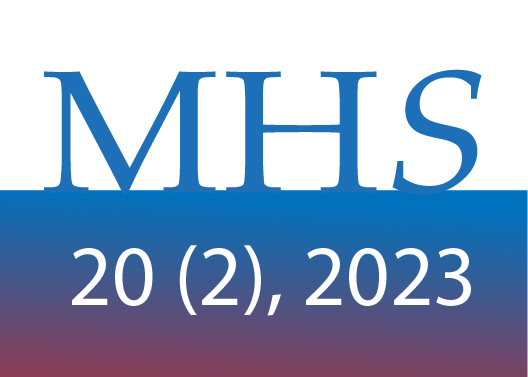Barreras e incentivos de la movilidad en un sistema de bicicletas compartidas en un municipio español
DOI:
https://doi.org/10.15359/mhs.20-2.6Palabras clave:
bicicleta, salud pública, promoción de la salud, actividad físicaResumen
Introducción: El interés por el ciclismo urbano está aumentando y el número de programas de bicicletas compartidas ha crecido rápidamente durante los últimos años. Por ello, el objetivo que se pretende alcanzar en este estudio es saber si los factores como las estaciones, los trayectos y las altitudes afectan el uso del sistema compartido de bicicletas en un municipio español.
Método: Se ha diseñado un estudio cuantitativo y longitudinal con recogida y análisis de datos del BSS de Vilagarcía de Arousa, que registra un total de 84 183 observaciones (hombres n = 59 159; mujeres n = 25 024). Los datos extraídos del sistema fueron recolectados y analizados estadísticamente, a través del programa IBM SPSS versión 21.0. Se ha establecido un valor de significación p < 0,05.
Resultados: La estación más utilizada fue la que se sitúa en el centro de la ciudad y representa un total del 39 % de las observaciones. La elevación neutra, es decir, salir de una estación y depositar la bicicleta en otra con la misma altitud, representó el 65,5 % de los registros totales.
Conclusiones: El municipio de Vilagarcía de Arousa reúne unas características topográficas favorables para ser un servicio rentable que fomente unos hábitos saludables, como un medio de transporte activo de desplazamiento en el entorno urbano, una mejora de la movilidad urbana y un entorno menos contaminado.
Referencias
Beenackers, M. A., Foster, S., Kamphuis, C., Titze, S., Divitini, M., Knuiman, M., van Lenthe, F. J. y Giles-Corti, B. (2012). Taking up cycling after residential relocation: built environment factors. American Journal of Preventive Medicine, 42(6), 610-615. https://doi.org/10.1016/j.amepre.2012.02.021
Bauman, A., Crane, M., Drayton, B. A. y Titze, S. (2017). The unrealised potential of bike share schemes to influence population physical activity levels–A narrative review. Preventive Medicine, 103, S7-S14. https://doi.org/10.1016/j.ypmed.2017.02.015
Beairsto, J., Tian, Y., Zheng, L., Zhao, Q. y Hong, J. (2022). Identifying locations for new bike-sharing stations in Glasgow: an analysis of spatial equity and demand factors. Annals of GIS, 28(2), 111-126. https://doi.org/10.1080/19475683.2021.1936172
Buck, D. y Buehler, R. (22-26 de enero de 2012). Bike lanes and other determinants of capital bikeshare trips. In Proceedings of the Transportation Research Board 91st Annual Meeting, Washington, DC, USA. https://nacto.org/wp-content/uploads/2012/02/Bike-Lanes-and-Other-Determinants-of-Capital-Bikeshare-Trips-Buck-et-al-12-3539.pdf
Chen, Z., van Lierop, D. y Ettema, D. (2020). Dockless bike-sharing systems: what are the implications?. Transport Reviews, 40(3), 333-353. https://doi.org/10.1080/01441647.2019.1710306
Clockston, R. L. M. y Rojas-Rueda, D. (2021). Health impacts of bike-sharing systems in the US. Environmental Research, 202, 111709. https://doi.org/10.1016/j.envres.2021.111709
Contardo, C., Morency, C. y Rousseau, L. M. (2012). Balancing a dynamic public bike-sharing system. CIRRELT.
Dekoster, J. y Schollaert, U. (2000). En bici, hacia ciudades sin malos humos. Oficina de Publicaciones Oficiales de las Comunidades Europeas.
DeMaio, P. (2009). Bike-sharing: History, impacts, models of provision, and future. Journal of Public Transportation, 12(4), 41-56. https://doi.org/10.5038/2375-0901.12.4.3
Eren, E. y Uz, V. E. (2020). A review on bike-sharing: The factors affecting bike-sharing demand. Sustainable Cities and Society, 54, 101882. https://doi.org/10.1016/j.scs.2019.101882
Faghih-Imani, A., Hampshire, R., Marla, L. y Eluru, N. (2017). An empirical analysis of bike sharing usage and rebalancing: Evidence from Barcelona and Seville. Transportation Research Part A: Policy and Practice, 97, 177-191. https://doi.org/10.1016/j.tra.2016.12.007
Garrard, J., Rose, G. y Lo, S. K. (2008). Promoting transportation cycling for women. The role of bicycle infrastructure. Preventive Medicine, 46, 55-59. https://doi.org/10.1016/j.ypmed.2007.07.010
Hu, B., Zhong, Z., Zhang, Y., Sun, Y., Jiang, L., Dong, X. y Sun, H. (2022). Understanding the influencing factors of bicycle-sharing demand based on residents’ trips. Physica A: Statistical Mechanics and its Applications, 586, 126472. https://doi.org/10.1016/j.physa.2021.126472
Hunt, J. D. y Abraham, J. E. (2007). Influences on bicycle use. Transportation, 34(4), 453-470. https://doi.org/10.1007/s11116-006-9109-1
Julio, R. y Monzon, A. (2022). Long term assessment of a successful e-bike-sharing system. Key drivers and impact on travel behaviour. Case Studies on Transport Policy, 10(2), 1299-1313. https://doi.org/10.1016/j.cstp.2022.04.019
Lee, M., Hwang, S., Park, Y. y Choi, B. (2022). Factors affecting bike-sharing system demand by inferred trip purpose: Integration of clustering of travel patterns and geospatial data analysis. International Journal of Sustainable Transportation, 16(9), 847-860. https://doi.org/10.1080/15568318.2021.1943076
Lu, W., Scott, D. M. y Dalumpines, R. (2018). Understanding bike share cyclist route choice using GPS data: Comparing dominant routes and shortest paths. Journal of Transport Geography, 71, 172-181. https://doi.org/10.1016/j.jtrangeo.2018.07.012
Ma, X., Yuan, Y., Van Oort, N. y Hoogendoorn, S. (2020). Bike-sharing systems’ impact on modal shift: A case study in Delft, the Netherlands. Journal of Cleaner Production, 259, 120846. https://doi.org/10.1016/j.jclepro.2020.120846
Macioszek, E., Świerk, P. y Kurek, A. (2020). The bike-sharing system as an element of enhancing sustainable mobility - A case study based on a city in Poland. Sustainability, 12(8), 3285. https://doi.org/10.3390/su12083285
Mateo-Babiano, I., Bean, R., Corcoran, J. y Pojani, D. (2016). How does our natural and built environment affect the use of bicycle sharing? Transportation Research Part A: Policy and Practice, 94, 295-307. https://doi.org/10.1016/j.tra.2016.09.015
Menghini, G., Carrasco, N., Schüssler, N. y Axhausen, K. W. (2010). Route choice of cyclists in Zurich. Transportation Research Part A: Policy and Practice, 44(9), 754-765. https://doi.org/10.1016/j.tra.2010.07.008
Midgley, P. (2009). The role of smart bike-sharing systems in urban mobility. Journeys, 2, 23-31. https://www.gtkp.com/assets/uploads/20091127-144837-7443-IS02-p23%20Bike-sharing.pdf
Mix, R., Hurtubia, R. y Raveau, S. (2022). Optimal location of bike-sharing stations: A built environment and accessibility approach. Transportation Research Part A: Policy and Practice, 160, 126-142. https://doi.org/10.1016/j.tra.2022.03.022
Munkácsy, A. y Monzón, A. (2017). Potential user profiles of innovative bike-sharing systems: the case of BiciMAD (Madrid, Spain). Asian Transport Studies, 4(3), 621-638. https://doi.org/10.11175/eastsats.4.621
Nieuwenhuijsen, M. J. y Rojas-Rueda, D. (2020). Bike-sharing systems and health (In) MJ, Nieuwenhuijsen and H, Khreis, Advances in Transportation and Health (239-250). Elsevier. https://doi.org/10.1016/B978-0-12-819136-1.00010-3
Ogilvie, F. y Goodman, A. (2012). Inequalities in usage of a public bicycle sharing scheme: Socio-demographic predictors of uptake and usage of the London (UK) cycle hire scheme. Preventive Medicine, 55(1), 40-45. https://doi.org/10.1016/j.ypmed.2012.05.002
Otero, I., Nieuwenhuijsen, M. J. y Rojas-Rueda, D. (2018). Health impacts of bike sharing systems in Europe. Environment International, 115, 387-394. https://doi.org/10.1016/j.envint.2018.04.014
Pucher, J., Buehler, R. y Seinen, M. (2011). Bicycling renaissance in North America? An update and re-appraisal of cycling trends and policies. Transportation Research Part A: Policy and Practice, 45(6), 451-475. https://doi.org/10.1016/j.tra.2011.03.001
Pucher, J., Garrard, J. y Greaves, S. (2011). Cycling down under: a comparative analysis of bicycling trends and policies in Sydney and Melbourne. Journal of Transport Geography, 19(2), 332-345. https://doi.org/10.1016/j.jtrangeo.2010.02.007
Pucher, J., Komanoff, C. y Schimek, P. (1999). Bicycling renaissance in North America? Recent trends and alternative policies to promote bicycling. Transportation Research Part A: Policy and Practice, 33(7), 625-654. https://doi.org/10.1016/S0965-8564(99)00010-5
Rietveld, P. y Daniel, V. (2004). Determinants of bicycle use: Do municipal policies matter? Transportation Research Part A: Policy and Practice, 38(7), 531-550. https://doi.org/10.1016/j.tra.2004.05.003
Rixey, R. A. (2013). Station-level forecasting of bikesharing ridership: Station network effects in three US systems. Transportation research record, 2387(1), 46-55. https://doi.org/10.3141/2387-06
Sanmiguel-Rodríguez, A. (2015). Ambiente urbano y bicicletas compartidas: efectos sobre la actividad física [tesis doctoral]. Universidade de Vigo. http://www.investigo.biblioteca.uvigo.es/xmlui/handle/11093/381
Sanmiguel-Rodríguez, A. (2019). Análisis de las edades, trayectos y minutos de uso en la utilización de un sistema de bicicletas compartidas: el caso del VaiBike en Vilagarcía de Arousa (España). Retos: Nuevas Tendencias en Educación Física, Deporte y Recreación, 35, 314-319. https://doi.org/10.47197/retos.v0i35.66470
Sanmiguel-Rodríguez, A. (2020). Cumplimiento de las recomendaciones de actividad física de la OMS por usuarios de bicicletas públicas en un municipio español. Revista Habanera de Ciencias Médicas, 19(3) e2955. http://www.revhabanera.sld.cu/index.php/rhab/article/view/2955
Sanmiguel-Rodríguez, A. (2022). Bike-sharing systems: Effects on physical activity in a Spanish municipality. Physical Activity Review, 10(2), 66-76. https://doi.org/10.16926/par.2022.10.22
Sanmiguel-Rodríguez, A. y Arufe Giráldez, V. (2019). Impact of climate on a bike-sharing system. Minutes of use depending on day of the week, month and season of the year. Cuadernos de Psicología del Deporte, 19(2), 102-112. https://doi.org/10.6018/cpd.338441
Scheiner, J. (2010). Interrelations between travel mode choice and trip distance: trends in Germany 1976-2002. Journal of Transport Geography, 18(1), 75-84. https://doi.org/10.1016/j.jtrangeo.2009.01.001
Soriguera, F. y Jiménez-Meroño, E. (2020). A continuous approximation model for the optimal design of public bike-sharing systems. Sustainable Cities and Society, 52, 101826. https://doi.org/10.1016/j.scs.2019.101826
Sun, F., Chen, P. y Jiao, J. (2018). Promoting public bike-sharing: A lesson from the unsuccessful Pronto system. Transportation Research Part D: Transport and Environment, 63, 533-547. https://doi.org/10.1016/j.trd.2018.06.021
Talavera-García, R., Romanillos, G. y Arias-Molinares, D. (2021). Examining spatio-temporal mobility patterns of bike-sharing systems: the case of BiciMAD (Madrid). Journal of Maps, 17(1), 7-13. https://doi.org/10.1080/17445647.2020.1866697
Tin, S. T., Woodward, A., Robinson, E. y Ameratunga, S. (2012). Temporal, seasonal and weather effects on cycle volume: an ecological study. Environmental Health, 11(12), 1-9. https://doi.org/10.1186/1476-069X-11-12
Unwin, N. C. (1995). Promoting the public health benefits of cycling. Public Health, 109(1), 41-46. https://doi.org/10.1016/S0033-3506(95)80074-3
Vandenbulcke, G., Dujardin, C., Thomas, I., de Geus, B., Degraeuwe, B., Meeusen, R. y Panis,
L. I. (2011). Cycle commuting in Belgium: spatial determinants and ‘re-cycling’ strategies. Transportation Research Part A: Policy and Practice, 45(2), 118-137. https://doi.org/10.1016/j.tra.2010.11.004
Zhang, L., Zhang, J., Duan, Z. Y. y Bryde, D. (2015). Sustainable bike-sharing systems: characteristics and commonalities across cases in urban China. Journal of Cleaner Production, 97, 124-133. https://doi.org/10.1016/j.jclepro.2014.04.006
Descargas
Publicado
Cómo citar
Número
Sección
Licencia
Condiciones generales

MHSalud: Revista en Ciencias del Movimiento Humano y Salud por Universidad Nacional se encuentra bajo una Licencia Creative Commons Atribución-NoComercial-SinDerivadas 3.0 Costa Rica.
La revista se aloja en repositorios de acceso abierto como el Repositorio Institucional de la Universidad Nacional, el Repositorio Kimuk de Costa Rica y la Referencia.
La fuente editorial de la revista debe reconocerse. Para ello utilice el identificador doi de la publicación.
Política de autoarchivo: La revista permite el auto archivo de los artículos en su versión arbitrada, editada y aprobada por el Consejo Editorial de la Revista para que sean disponibles en Acceso Abierto a través de Internet. Más información en el siguiente link: https://v2.sherpa.ac.uk/id/publication/25815


















